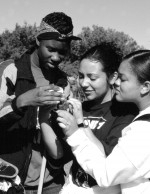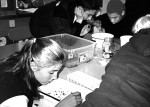In 1998 NSF granted small supplements to sites that expressed interest in developing Schoolyard LTER programs. Many sites were able to fit the supplements into existing informal K-12 education efforts, while others began new programs from scratch.
Simultaneously, the LTER Network formed a working group of PIs and interested individuals associated with LTER sites, who participated in the LTER Education Workshop in October 1998 (see fall 1998 issue of the Network Newsletter). The workshop produced ideas, resources, and concrete information that sites used to begin their Schoolyard programs.
Bruce Hayden, who will complete his two-year rotation as Director of the Division of Environmental Biology in the Directorate for Biological Sciences (BIO) at the National Science Foundation (NSF), established the Schoolyard LTER supplement funding and believes it will survive beyond his tenure. "The start up of the Schoolyard LTER program has earned good marks from both BIO and NSF," Hayden says. "Funds for the program are in the Ecological Studies Cluster education fund budget and are included in the draft budget for FY 2000 that I will give to my replacement for next year."
The resources for recent Information Technology upgrades for LTER sites were directly benefited by the Schoolyard LTER component of the proposal for the funds. "The Schoolyard LTER activity is an important bridge between research and education and has broad support for the coming years," Hayden says.
Each site has a unique approach to utilizing the supplements. Some insert the new funding into existing programs, while others start from scratch, inventing new programs to involve K-12 students and teachers with their LTER sites.
North Temperate Lakes LTER has formed a partnership with the Center for Biology Education (CBE) at the University of Wisconsin. "We are working closely with the folks at CBE," says Tim Kratz, NTL PI. "[They are] providing educational leadership on this activity. So far the actual activities with the schools have involved both LTER researchers and CBE people."
Robert Bohanan (outreach program manager, CBE) has taken the lead for the NTL Schooyard LTER program. NTL LTER PI’s John Magnuson, Tim Kratz and Ann McLain worked together with Bohanan to develop a "winter limnology experience" at the Trout Lake Station and Lake Mendota LTER sites. Students from participating classes learned techniques for sampling biological, ecological, chemical, and studied physical attributes of lakes.
"Nearly 100 students and seven teachers participated," Bohanan said. "Students from each site are now summarizing their data and results and will then share these via e-mail." Learn more about the CBE at: http://www.wisc.edu/
At Bonanza Creek LTER, Dr. John ‘Jock’ Irons, liason between LTER and Fairbanks teachers, and a research associate at the University of Alaska Fairbanks (UAF), and Dr. Elena Sparrow, Alaska Global Change Education Co-coordinator, UAF are managing the Schoolyard LTER supplement.
"We motivate teachers to participate by offering them scientific support in their classrooms," Elena Sparrow says. "We train them in the Global Learning and Observations to Benefit the Environment (GLOBE) program," an established environmental science and education program designed to enhance student achievement, improve scientific understanding of the earth, and increase environmental awareness and appreciation by involving scientists, teachers and their students in long-term, worldwide research projects. Another established program, Partners in Science (PIS), also lends support to beginning programs like the BNZ Schoolyard LTER.
"We make ourselves available to help in the classroom as guest presenters or by providing support as they train their students in scientific measurements." Sparrow says that offering scientific instruments and materials needed for their participation in the project generates interest from teachers, as well.
Motivating LTER scientists to participate can be more difficult. "We try to explain how getting involved with K-12 science education is rewarding, and how it is a good way of preparing future research scientists," Sparrow says. "We also remind them that it is a way of getting data that otherwise would not be available to them." More input from LTER PIs would contribute a great deal to the effort, she says.
Starting the Schoolyard LTER project with the supplemental funding has been a slow process, Sparrow says, but she finds her motivation in the participants. "The enthusiasm of teachers involved is contagious. We have a lot to learn from the K-12 teachers in our efforts to bring research into the classroom and to make it more meaningful to their students."
Valerie Wright, the part time environmental educator at Konza Prairie LTER, says the first $15K supplement provided seed money to begin a program to introduce teachers to LTER research principles.
The new education program at Konza has field activities that allow direct contact between students and LTER researchers.
"The kids were in awe of the researchers and graduate students because of their knowledge and experience with handling insects. They learned how to pick up a spider without being frightened and were amazed at how many different grasshoppers they could find. The butterfly collection even got a new genus not before collected on Konza! We knew it was probably here but didn’t have a specimen."
Valerie adds that the small supplement does not allow for any monetary incentives."The teacher we worked with spent a tremendous amount of time in-putting data and working out an analysis. I feel uncomfortable asking teachers, who are so busy anyway, to spend hours and hours on data sets. We really need to have everything set up for them by someone associated with the LTER program or we will burn out those interested and not get others to cooperate at all."
Wright says the initial activity is exciting and has potential, but needs expansion. "We need someone to help set up data management and accessibility to data sets for teachers as well as help with interpretation, and an assistant to the educator, so our efforts would not be so limited."

 Enlarge this image
Enlarge this image

